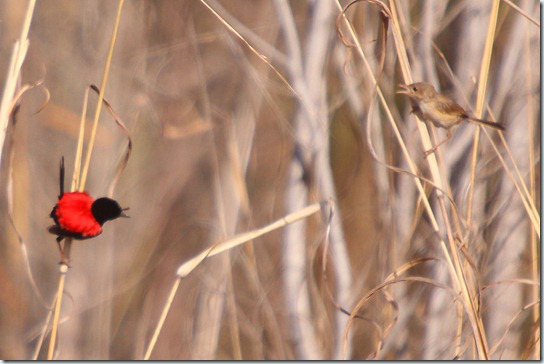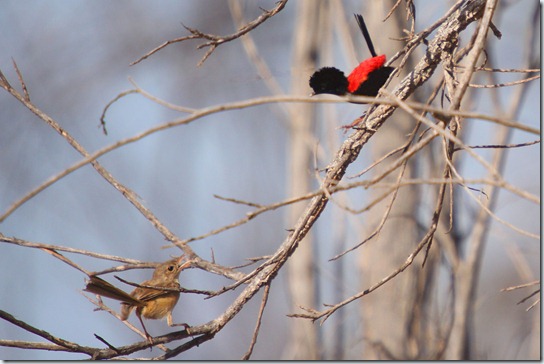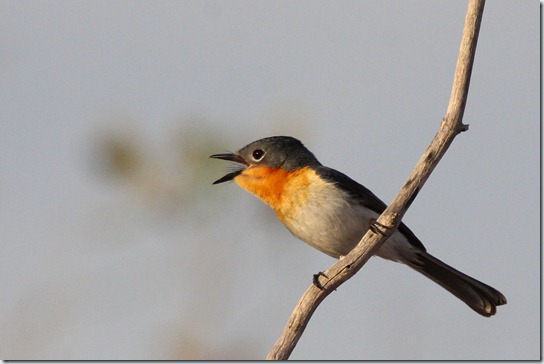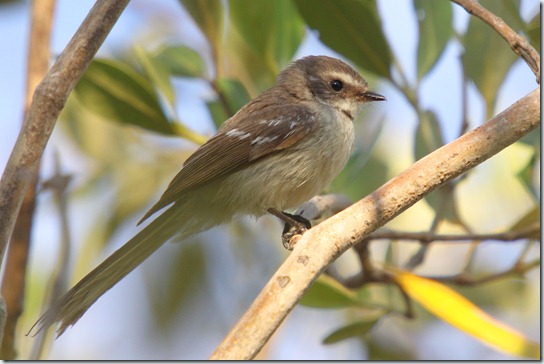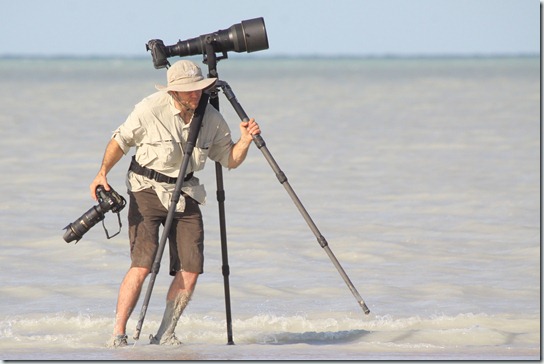Courtship routine of the Red-backed Fairywren, in the twiggy shrubs across from the Roebuck Roadhouse. They were constantly on the move, and quite distant, but it was great to see how the male fluffed up his head feathers and displayed the wonderful red feathers in a birdy cape.
Thursday, October 14, 2010
Monday, October 11, 2010
Roebuck Bay

Photo tips from Craig Ingram, our instructor.
- Use a tripod, to maximise sharpness.
- Use aperture priority mode, to give maximum shutter speed for the situation.
- Use AI servo mode, to keep a moving subject in focus.
- Expose to the right of the histogram, to maximise quality.
- Use auto white balance and adjust in post-processing.
- Remember that the quality of the light is the life blood of the image.
- The frame boundaries are the primary tool in composition, be decisive about what is in and what is out.
Two Dog Hermit
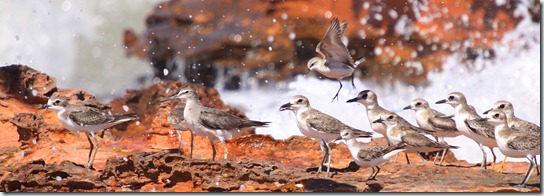
Our morning workshop on the 7th was at Two Dog Hermit, where large mixed groups of waders gather on the off-shore rocks as the mud flats disappear under the incoming tide before moving to the beach.
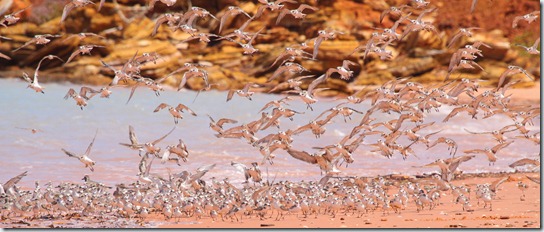
A sea research team from the Netherlands identified over 280 different mud creatures from thin the Roebuck Bay tidal flats. The waders stick close to the edge of the tide as they feed, following the bivalves that are close to the surface at the water’s edge, but bunker down deeper into the mud as the tide recedes.
Eventually, as the tide brings lunch to a close, birds can catch a quick nap.
But instead of simply moving higher on the beach they were feeding on, they strangely commute up to 120kms a day between shady roost sites and the exposed mud flats. Beaches that held huge flocks the day before, may be empty the next day.
As the tide gets higher the hide tide mark is too close to the cliffs for the birds to relax. This day the birds were edgy, with flocks arriving and leaving alternately. The ten metre tide eventually lapped against the edge of the Pindan cliffs, and the birds had gone, perhaps to the plains or the wetlands of the sewerage ponds.
One Tree
Next day the high tide was a little later in the morning, so we went to One Tree to look for birds in the mangroves and get images of individual waders feeding on the mud flats.
First bird of the day was a broad-billed flycatcher, moving between three favoured perches to sing in the early morning light, followed by a mangrove grey fantail who proved more of a challenge to capture as he constantly flittered through the mangroves. White-breasted wood-swallows perched in the dead trees on the other side of Crab Creek, and yellow white-eyes were in abundance.
In George Swan’s guide to birding the area, he recommends birding the Big Crab Creek trail close to a neap tide as you need to cross Little Crab Creek and you will get stranded on a higher tide. He also gives specific instructions on where to cross Little Crab Creek to avoid the deepest mud. We crossed in plenty of time, and for the most part we stayed out of the mud. We were given specific instructions to be back at the creek crossing within 30 minutes, and divided up into ones and twos to creep up on individual birds feeding. It was a successful morning, with the valuable lesson learned that “40 minutes” isn’t really close enough to “30 minutes”. We had to go further upstream to cross Little Crab Creek and ended up knee deep in mud and thigh deep in water, ferrying cameras and tripods over our head. My shoes stuck in an underwater mud bank, and I left them there.
But using our newly learned birding and photography techniques, we did capture some great images of the waders.
Ruddy Turnstone
Black-tailed Godwit
Friday, October 8, 2010
Horse Pond
Campsite Beach
I happened to choose well and was rewarded with some images of the huge number of waders that spend the summer on the shores of Roebuck bay.
Some of the birds are still showing their breeding colours. After a period of watching them closely they started to develop distinct personalities. The terek sandpipers are busy birds, even when others are closing their eyes they are still pottering about. The greenshanks are nervy, first to scatter as a white-breasted sea eagle, brahminy kite, or whistling kite flew overhead.
Tuesday, October 5, 2010
Broome Bird Observatory
The tour gave us a full day on Roebuck plains station, which involved a range of habitat including tropical wetland, pindan woodland and grassland, and the microhabitats around natural waterholes and man-made bore dams.
Broome Bird Observatory
The Observatory is a staging point of international significance for migratory waders. Located on the shores of Roebuck Bay about 25k from Broome is offers cabins and camping in an ideal location for viewing thousands of birds waiting out the Siberian winters. The area has the greatest diversity of waders of any place in Australia, and offers self-guided walks, tours, courses, and an extensive book and video library. Visitors can take part in ongoing field research, or just watch the birds from the cabin verandah.
We took a short walk down to the beach, but it was too hot to stay out and the tide was well out so the wader were scattered across miles of mudflat. A group or thirty pied oystercatchers were bathing in a creek across the flat and squabbling amongst themselves, and seven grey-crowned babblers were babbling as the gleaned the trees along the shoreline.
After a now routine midday nap, I was woken by two grey shrike thrush calling to each other from perches just outside our back door. I set myself up in the shadehouse – the social hub of the BBO. With cold water on tap, insect screens, birding books and journals and bird baths just metres away it was a great spot to spend the afternoon. Double-barred finches were the stars of the bird bath show, gathering in large numbers, but there were also yellow white-eyes, long-tailed finches, rufous throated honeyeaters, little friarbirds, willie wagtails, brown honeyeaters, grey shrike thrush, great bower birds and several agile wallaby. A brown goshawk flew in to drink and bathe, and then wait under cover of a shrub. The willie wagtails chattered an alarm, and everything went quiet at the bird baths.
In the cool of the late afternoon we took a walk along the Pindan Trail. Numbered post along the trail pointed out significant features which were described in a brochure. The word “pindan” means “waterless open bush” and describes both the red soil of the area and the scrubby woodland it supports. Under a bauhinia tree along the trail was a beautiful great bowerbird bower, a perfectly formed tunnel with an impressive collection of white objects at either end mostly shells and pieces of bone.
Back to base to wash off the bulk of the red dirt, the Broom equivalent of dressing for dinner, in time for the regular 6:00pm bird call. Wonderful to hear what others had seen during the day!
Sunday, October 3, 2010
Coconut Wells
We are getting into a holiday routine. Catch a sunrise, breakfast, birding walk, photo editing and siesta, another birding outing, dinner and photo editing. This afternoon's outing was to Cocunut Wells. We took the Cape Leveque Road almost to the end of the bitumen where there was a dam on the right-hand side of the road. A large group of red tailed black cockatoos called from high in distant trees. Great bowerbirds and diamond doves came down to drink and bathe, but there was no shade close to the water, and it was too hot to wait in the sun so we turned back to the Coconut Wells turnoff.
The huge lagoon was dry, it apparently only fills on king tides at which time birds gather in throngs. Today there were only kids on quad bikes to be seen. But the bushes along the raod to the beach were fruiting attracting silvereyes and mistletoe birds. Brown honeyeaters were scolding from the scrub, male variegated fairywren offered teasing glimpses of their breeding plumage while the duller females posed, and a flycatcher sang grom a perch on a grass stalk.
Returning to the carpark we got talking to a guy fixing the railing fence, who said if we continued on the sandy track, past the round about we'd come to a packed limestoney trail through saltmarsh, and if we followed it for, well, a couple of Ks we'd see a big group of brolgas. "You'd make it in that, OK" he said, nodding at our rental Rav 4. Well say no more, we were on our way. It was a little hair-raising at times, I'd have liked a little more clearance in some deeply rutted sections, but oncoming vehicles kindly left the single track to let us by, and we managed a few deep sand sections without a problem. And we were rewarded with brolgas. A group of fourteen birds strolling in the late afternoon sun.
Kimberley Coast
We spent the morning on a whale watching trip which offered distant views of lesser frigate birds, wilson's storm petrel and brown boobys and close-ups of silver gulls. We came across a mass of fish which were being herded by dolphin, and a mother humpback whale and calf idly resting on the surface of the water. No spy hops, breaching or tail slaps, but I did capture a fin slap and it was great to watch them just relaxing.
Saturday, October 2, 2010
Cable Beach
A walk along Cable Beach after breakfast provided some relief from the heat. There were half a dozen different species of wader in groups of twos and threes amongst the rocks, which provided a less than truly comfortable perch to sit and wait for them to come within camera distance.
The stints kept chasing each other, the red-capped plovers darting along the sand chasing something unseen, the pacific golden plovers washined their tit-bits in the rock pools before eating, and the sandplovers went about their foraging in an orderly manner.
Gantheaume Point
We wandered out to Gantheaume Point at first light to capture the early sun on the red rocks. At the communication tower a pair of Osprey were ignoring the cry of two fledged chicks, though this bird looked as though it was drying off after a recent fishing trip.
On the road out a collared sparrow hawk watched the scrub from the powerlines.
Friday, October 1, 2010
Derby Sewage Overflow
The overflow was a series of ponds edged by deep reedbanks. Golden-headed cisticola serenaded from the reeds, and red-backed fairywrens and double-barred finches sheltered from the heat in dense low shrubs. We found a spot under a paperbark that gave good views of the waders, though they stayed on the far bank with its shelter of reeds.
We went to the mangroves near the export facilitity where a dozen black kite wheeled overhead, and a couple of small waders fossicked at the waters edge but the mud was thick and sticky and the temperature had reached 40 C, so we decided any birds in the mangroves would remain unobserved.
On the way out of town we drove past the airport where someone had reported seeing 10,000 oriental pratincoles some years ago. We didn't see 10,000 pratincoles - actually we didn't see a single bird.
